Research Highlights
Residential Yards are for the Birds (Sometimes)
 Few homeowners realize that when they are landscaping their yards, they are inadvertently creating habitats for birds, insects, and other animals that call urban areas home. Past CAP research has already established that residential landscaping in the Phoenix area has increased plant diversity compared to the native Sonoran desert due to the introduction of many exotic species of plants. Recent investigations have examined what residential landscaping choices mean for bird species in the city.
Few homeowners realize that when they are landscaping their yards, they are inadvertently creating habitats for birds, insects, and other animals that call urban areas home. Past CAP research has already established that residential landscaping in the Phoenix area has increased plant diversity compared to the native Sonoran desert due to the introduction of many exotic species of plants. Recent investigations have examined what residential landscaping choices mean for bird species in the city.
Soil Lead Distribution and Environmental Justice
 Lead is a toxin that affects cognitive abilities in children. While people often think of air and water as pathways for environmental contaminants, soil is a major sink for environmental pollutants, including lead. Children can be exposed to lead through contaminated soil.
Lead is a toxin that affects cognitive abilities in children. While people often think of air and water as pathways for environmental contaminants, soil is a major sink for environmental pollutants, including lead. Children can be exposed to lead through contaminated soil.
Former CAP Ph.D. student Xiaoding Zhuo investigated lead in Phoenix metropolitan area soils, using CAP’s Survey 200 soil samples. Survey 200 is a long-term monitoring initiative that investigates changes in soils, plants, insects, and land use at 204 points located randomly across the metropolitan area and surrounding desert.
Read More »Phoenix: Land of 1,400 (Artificial) Lakes
 Beginning with Hohokam irrigation canal construction over a thousand years ago, alterations to desert water systems have characterized the Phoenix area. Artificial lakes, constructed to connote a “desert oasis,” are among the most visible of these human created water features.
Beginning with Hohokam irrigation canal construction over a thousand years ago, alterations to desert water systems have characterized the Phoenix area. Artificial lakes, constructed to connote a “desert oasis,” are among the most visible of these human created water features.
While investigating artificial lakes, CAP Ph.D. student Libby Larson and CAP scientist Nancy Grimm found that existing maps of lakes in the metropolitan Phoenix area contained numerous inaccuracies. To create an accurate map, they used remote sensing imagery, GIS datasets, and state impoundment-permit information to identify lakes. Their work determined that there are between 900 and 1400 artificial lakes in the Phoenix metropolitan area, covering an area ranging from 7.9 to 8.2 km2, approximately 0.4% of the urbanized area (Figure 1).
Read More »The Western Black Widow Spider: From Desert Predator to Urban Pest
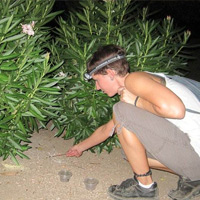 Urbanization is typically accompanied by a decline in biodiversity, yet certain species seem to thrive in urban areas where features of the native ecosystem have been greatly altered. In the Phoenix metropolitan area, the western black widow spider (Latrodectus hesperus) has become an urban pest, forming dense populations in the city. Since the venom of widow spiders is particularly dangerous to humans, their presence is not welcome in these human-shaped habitats. Instead, black widows are a factor in a vigorous pest management industry that homeowners depend on to rid their homes and yards of spiders, scorpions, roaches, and other undesirable arthropods.
Urbanization is typically accompanied by a decline in biodiversity, yet certain species seem to thrive in urban areas where features of the native ecosystem have been greatly altered. In the Phoenix metropolitan area, the western black widow spider (Latrodectus hesperus) has become an urban pest, forming dense populations in the city. Since the venom of widow spiders is particularly dangerous to humans, their presence is not welcome in these human-shaped habitats. Instead, black widows are a factor in a vigorous pest management industry that homeowners depend on to rid their homes and yards of spiders, scorpions, roaches, and other undesirable arthropods.
Urbanization Effects on Native Bird Populations
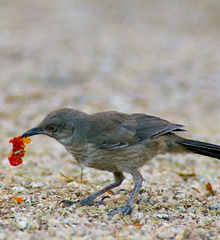 Urbanization in the desert has changed the environment for native birds by transforming the vegetation structure, increasing access to water, and altering predation levels. CAP researchers Dr. Pierre Deviche, Dr. Bobby Fokidis, and Ph.D. candidate Scott Davies seek to understand the effects of urbanization on birds and the mechanisms that drive bird behavior. They are particularly interested in the role that hormones play in controlling behaviors.
Urbanization in the desert has changed the environment for native birds by transforming the vegetation structure, increasing access to water, and altering predation levels. CAP researchers Dr. Pierre Deviche, Dr. Bobby Fokidis, and Ph.D. candidate Scott Davies seek to understand the effects of urbanization on birds and the mechanisms that drive bird behavior. They are particularly interested in the role that hormones play in controlling behaviors.
Recently published research from the Deviche lab focuses on the territorial behavior of native birds in the city versus their desert counterparts and the relationships between this behavior, circulating hormones, and ecosystem structure. Fokidis, Deviche, and Miles Orchinik centered their investigations on males of two bird species found in the Sonoran Desert and the Phoenix metropolitan area, Abert’s Towhee (Melozone aberti) and the Curve-billed Thrasher (Toxostoma curvirostre). They recorded the two species’ responses to recorded bird calls that simulated an intrusion on territory.
Read More »Patterns and Drivers of Land Fragmentation in Five Cities
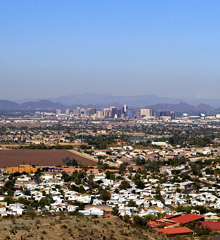 Land fragmentation is a major concern in rapidly urbanizing cities of the Southwest, mostly caused by discontinuous, low-density development over the last few decades. It has negative consequences for socio-ecological systems through disconnecting habitat, destroying migration corridors, increasing costs of public service provision, and increasing transportation distances from home to work.
Land fragmentation is a major concern in rapidly urbanizing cities of the Southwest, mostly caused by discontinuous, low-density development over the last few decades. It has negative consequences for socio-ecological systems through disconnecting habitat, destroying migration corridors, increasing costs of public service provision, and increasing transportation distances from home to work.
A cross-LTER site research initiative has examined land fragmentation across the five cities and metropolitan areas associated with the Central Arizona-Phoenix (Phoenix, Arizona), Sevilleta (Albuquerque, New Mexico), Jornada (Las Cruces, New Mexico), Short Grass Steppe (Fort Collins, Colorado), and Konza Prairie (Manhattan, Kansas) Long Term Ecological Research (LTER) sites.
Read More »Socioecological Drivers of Residential Landscape Management and Ecosystem Responses
 CAP LTER scientists Kelli Larson and Sharon Hall along with a team of graduate and undergraduate researchers have begun investigating residential landscapes in four neighborhoods in Phoenix, Arizona.
CAP LTER scientists Kelli Larson and Sharon Hall along with a team of graduate and undergraduate researchers have begun investigating residential landscapes in four neighborhoods in Phoenix, Arizona.
These distinct neighborhoods, which capture variations in landscaping and a cross-section of household incomes, are co-located with Survey 200 and Phoenix Area Social Survey field sites, allowing the researchers to draw on existing rich data sets.
Read More »Experimental Flood to Study Nitrogen Fluxes and Transformations
 Storm water retention basins are a ubiquitous feature in Phoenix’s residential and commercial areas. They concentrate water, nutrients, and pollutants from storm water runoff. While these basins can be important sites for improving storm water quality and recharging groundwater, they may also be sources of greenhouse gases.
Storm water retention basins are a ubiquitous feature in Phoenix’s residential and commercial areas. They concentrate water, nutrients, and pollutants from storm water runoff. While these basins can be important sites for improving storm water quality and recharging groundwater, they may also be sources of greenhouse gases.
In this video, CAP LTER graduate student Libby Larson experimentally floods a storm water retention basin at a north Phoenix elementary school in order to better understand how nitrogen behaves in this system.
Read More »Diversity of Ionizing-Radiation Resistant Bacteria
 To the average person, desert soils can appear to be dry, lifeless environments. Research conducted by Fred Rainey and his colleagues on microbial biodiversity dispels this myth and offers insight into characteristics of some bacteria found in arid environments.
To the average person, desert soils can appear to be dry, lifeless environments. Research conducted by Fred Rainey and his colleagues on microbial biodiversity dispels this myth and offers insight into characteristics of some bacteria found in arid environments.
Rainey’s lab at Louisiana State University analyzed the ionizing-radiation fractions of soil bacterial communities in a soil sample taken from the CAP LTER study area.
Read More »The Relationship between Pollen and Extant Vegetation across an Arid Urban Ecosystem and Surrounding Desert in Southwest USA
 Due to its dry climate and limited vegetation, desert areas of Arizona were once a haven for individuals seeking allergen-free environments. Landscaping in the rapidly growing Phoenix metropolitan area has altered the pollen composition of this desert environment, with implications for allergy sufferers.
Due to its dry climate and limited vegetation, desert areas of Arizona were once a haven for individuals seeking allergen-free environments. Landscaping in the rapidly growing Phoenix metropolitan area has altered the pollen composition of this desert environment, with implications for allergy sufferers.
- How does pollen abundance map against plant abundance across agricultural versus desert versus urban landscapes?
- How well defined or delineated are the pollen-plant relationships? Can plant taxa be grouped according to the degree of correlation between pollen and plant cover abundance?
- Can plant taxa be grouped depending on how well the presence or absence of the extant plant taxa correlate with the presence or absence of pollen across the entire study area?
- Are the findings of the relationships between extant vegetation and pollen and the distribution of pollen in line with expected results or are these relationships confounded by disturbance and manipulation of plant diversity in the agro-urban environment?
Social Vulnerability, Environmental Inequity, and Childhood Asthma
 Metropolitan Phoenix ranks in the top five US cities for asthma-related deaths. Approximately 8% of the Phoenix population has asthma, and research conducted in a low-income Latino neighborhood found that 16% of children under 19 years old had been diagnosed by a doctor as having asthma; this is twice the national average.
Metropolitan Phoenix ranks in the top five US cities for asthma-related deaths. Approximately 8% of the Phoenix population has asthma, and research conducted in a low-income Latino neighborhood found that 16% of children under 19 years old had been diagnosed by a doctor as having asthma; this is twice the national average.
Sara Grineski investigated the relationships between socioeconomic status, race, ethnicity, indoor hazards, ambient environmental hazards, and asthma hospitalization rates, to understand how these factors contribute to the incidence of childhood asthma and how families cope with childhood asthma. The study asked:
Do socio-spatial inequalities explain patterns in uncontrolled childhood asthma?
- How do parents have differential control of children’s asthma?
- How have historical and geographical processes influenced inequalities associated with asthma control?
Agrarian Legacy in Soil Nutrient Pools of Urbanizing Arid Lands
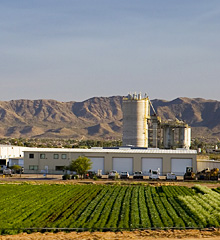 Today’s worldwide expansion of dryland cities consumes cultivated and native ecosystems. Urbanization of dryland farms may have biogeochemical consequences that differ from those accompanying farmland transformations in other biomes.
Today’s worldwide expansion of dryland cities consumes cultivated and native ecosystems. Urbanization of dryland farms may have biogeochemical consequences that differ from those accompanying farmland transformations in other biomes.
In temperate regions, soil organic matter (SOM) pools often decline during cultivation. In dry regions, however, farms replace native ecosystems with inherently small soil nutrient pools, which may gain rather than lose carbon (C) and SOM upon land transition. Around Phoenix, Arizona, USA, we compared soil nutrient pools in residential yards converted from farms to nutrient pools in yards developed on native desert.
Read More »From Patterns to Emerging Processes in Mechanistic Urban Ecology
 Until recently, urban ecologists focused mainly on patterns of species abundance and diversity. Only in recent years has research progressed into mechanistic urban ecology, with studies (mostly experimental) on behavioral ecology, species interactions, genetics, and evolution.
Until recently, urban ecologists focused mainly on patterns of species abundance and diversity. Only in recent years has research progressed into mechanistic urban ecology, with studies (mostly experimental) on behavioral ecology, species interactions, genetics, and evolution.
Although this mechanistic approach is still in its infancy, it already indicates that the urban environment is a unique setting, in which fundamental patterns and processes can be decoupled by human activities. Thus, ecological “rules” in urban environments might differ dramatically from those in less human-influenced habitats. The tools used to understand these differences must also address the role of human behavior as a primary driving force of environmental change.
Read More »The North Desert Village Landscaping Experiment
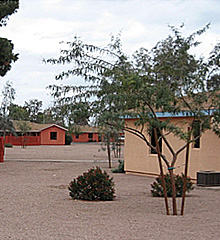 In 2003, CAP LTER researchers started setting up a large-scale landscape experiment around student family housing on the Arizona State University Polytechnic Campus. The experiment is designed to give a platform for CAP LTER researchers to study human-landscape interactions as well as biogeochemistry and populations dynamics under controlled conditions.
In 2003, CAP LTER researchers started setting up a large-scale landscape experiment around student family housing on the Arizona State University Polytechnic Campus. The experiment is designed to give a platform for CAP LTER researchers to study human-landscape interactions as well as biogeochemistry and populations dynamics under controlled conditions.
Major research questions include:
- How do landscape design and irrigation methods affect NPP and neighborhood microclimate, soil nutrient pools and fluxes, insect abundance and diversity, and bird activity?
- How does landscape design affect direct human-landscape interactions in terms of both perceptions and behaviors?
Some Early Findings of the CAP LTER
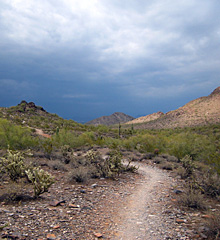 Among the significant discoveries resulting from the first three years of Central Arizona – Phoenix LTER studies, three stand out for their scientific generality and potential social relevance.
Among the significant discoveries resulting from the first three years of Central Arizona – Phoenix LTER studies, three stand out for their scientific generality and potential social relevance.
Due to the urban location of the CAP LTER, the results of these studies and many others are of immediate service to society. Understanding the ecological changes that accompany new housing and urban sprawl will allow for more rational city planning, while knowledge of nutrient sources and sinks in the urban environmental will lead to more efficient construction of infrastructure.
The insights we are gaining on the nature of environmental risks and how they are differentially borne by citizens will enhance city planning and possibly an enhanced quality of life.
Read More »
